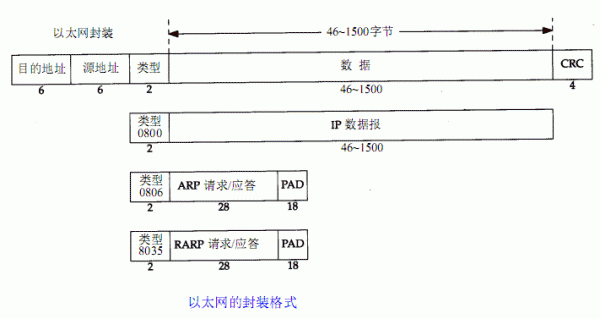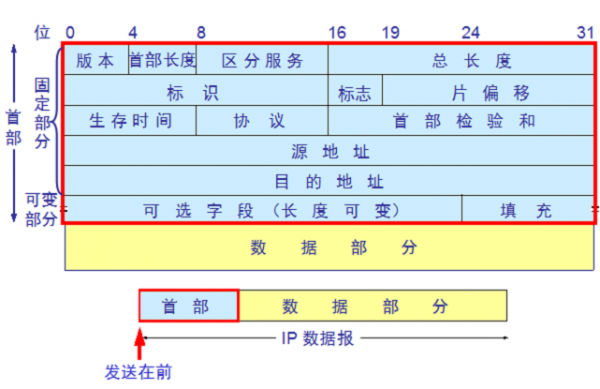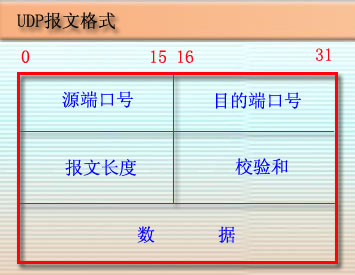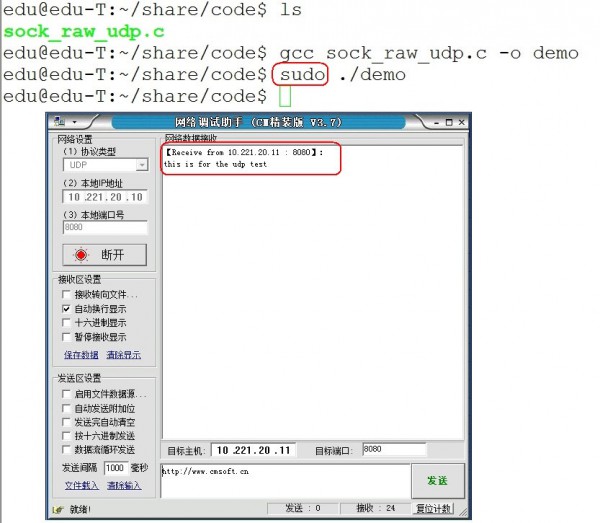Linux 网络编程――原始套接字实例:发送 UDP 数据包
来源:程序员人生 发布时间:2015-04-30 09:09:13 阅读次数:3928次
以太网报文格式:

详细的说明,请看《MAC 头部报文分析》。
IP 报文格式:

详细的说明,请看《IP 数据报格式详解》。
UDP 报文格式:

详细的说明,请看《UDP
数据报格式详解》。
校验和函数:
/*******************************************************
功能:
校验和函数
参数:
buf: 需要校验数据的首地址
nword: 需要校验数据长度的1半
返回值:
校验和
*******************************************************/
unsigned short checksum(unsigned short *buf, int nword)
{
unsigned long sum;
for(sum = 0; nword > 0; nword--)
{
sum += htons(*buf);
buf++;
}
sum = (sum>>16) + (sum&0xffff);
sum += (sum>>16);
return ~sum;
}
这里是在 ubuntu 下通过原始套接字组1个 udp 数据包,给 PC 机的网络调试助手发送信息:
#include <stdio.h>
#include <stdlib.h>
#include <string.h>
#include <net/if.h> //struct ifreq
#include <sys/ioctl.h> //ioctl、SIOCGIFADDR
#include <sys/socket.h>
#include <netinet/ether.h> //ETH_P_ALL
#include <netpacket/packet.h> //struct sockaddr_ll
unsigned short checksum(unsigned short *buf, int nword);//校验和函数
int main(int argc, char *argv[])
{
//1.创建通讯用的原始套接字
int sock_raw_fd = socket(PF_PACKET, SOCK_RAW, htons(ETH_P_ALL));
//2.根据各种协议首部格式构建发送数据报
unsigned char send_msg[1024] = {
//--------------组MAC-------⑴4------
0x74, 0x27, 0xea, 0xb5, 0xef, 0xd8, //dst_mac: 74⑵7-EA-B5-FF-D8
0xc8, 0x9c, 0xdc, 0xb7, 0x0f, 0x19, //src_mac: c8:9c:dc:b7:0f:19
0x08, 0x00, //类型:0x0800 IP协议
//--------------组IP--------⑵0------
0x45, 0x00, 0x00, 0x00, //版本号:4, 首部长度:20字节, TOS:0, --总长度--:
0x00, 0x00, 0x00, 0x00, //16位标识、3位标志、13位片偏移都设置0
0x80, 17, 0x00, 0x00, //TTL:128、协议:UDP(17)、16位首部校验和
10, 221, 20, 11, //src_ip: 10.221.20.11
10, 221, 20, 10, //dst_ip: 10.221.20.10
//--------------组UDP-------⑻+78=86------
0x1f, 0x90, 0x1f, 0x90, //src_port:0x1f90(8080), dst_port:0x1f90(8080)
0x00, 0x00, 0x00, 0x00, //#-⑴6位UDP长度-⑶0个字节、#16位校验和
};
int len = sprintf(send_msg+42, "%s", "this is for the udp test");
if(len % 2 == 1)//判断len是不是为奇数
{
len++;//如果是奇数,len就应当加1(由于UDP的数据部份如果不为偶数需要用0弥补)
}
*((unsigned short *)&send_msg[16]) = htons(20+8+len);//IP总长度 = 20 + 8 + len
*((unsigned short *)&send_msg[14+20+4]) = htons(8+len);//udp总长度 = 8 + len
//3.UDP伪头部
unsigned char pseudo_head[1024] = {
//------------UDP伪头部-------⑴2--
10, 221, 20, 11, //src_ip: 10.221.20.11
10, 221, 20, 10, //dst_ip: 10.221.20.10
0x00, 17, 0x00, 0x00, //0,17,#-⑴6位UDP长度-⑵0个字节
};
*((unsigned short *)&pseudo_head[10]) = htons(8 + len);//为头部中的udp长度(和真实udp长度是同1个值)
//4.构建udp校验和需要的数据报 = udp伪头部 + udp数据报
memcpy(pseudo_head+12, send_msg+34, 8+len);//--计算udp校验和时需要加上伪头部--
//5.对IP首部进行校验
*((unsigned short *)&send_msg[24]) = htons(checksum((unsigned short *)(send_msg+14),20/2));
//6.--对UDP数据进行校验--
*((unsigned short *)&send_msg[40]) = htons(checksum((unsigned short *)pseudo_head,(12+8+len)/2));
//6.发送数据
struct sockaddr_ll sll; //原始套接字地址结构
struct ifreq ethreq; //网络接口地址
strncpy(ethreq.ifr_name, "eth0", IFNAMSIZ); //指定网卡名称
if(⑴ == ioctl(sock_raw_fd, SIOCGIFINDEX, ðreq)) //获得网络接口
{
perror("ioctl");
close(sock_raw_fd);
exit(⑴);
}
/*将网络接口赋值给原始套接字地址结构*/
bzero(&sll, sizeof(sll));
sll.sll_ifindex = ethreq.ifr_ifindex;
len = sendto(sock_raw_fd, send_msg, 14+20+8+len, 0 , (struct sockaddr *)&sll, sizeof(sll));
if(len == ⑴)
{
perror("sendto");
}
return 0;
}
unsigned short checksum(unsigned short *buf, int nword)
{
unsigned long sum;
for(sum = 0; nword > 0; nword--)
{
sum += htons(*buf);
buf++;
}
sum = (sum>>16) + (sum&0xffff);
sum += (sum>>16);
return ~sum;
}
运行结果以下:

源代码下载请点此处。
生活不易,码农辛苦
如果您觉得本网站对您的学习有所帮助,可以手机扫描二维码进行捐赠





